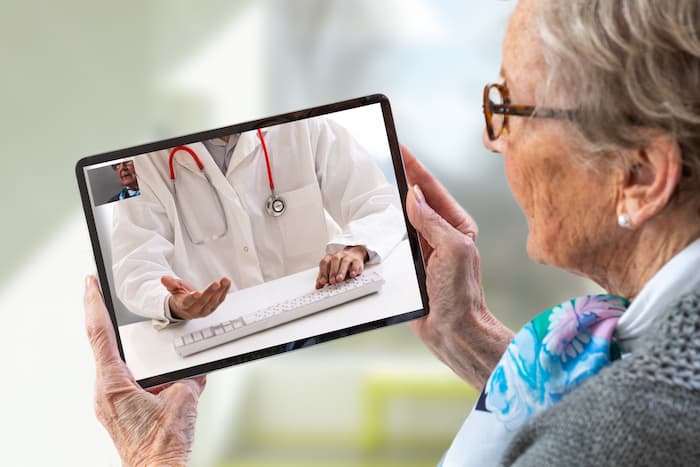Insider Intelligence estimates 30 million U. S. patients will use remote patient monitoring (RPM) tools by 2024. This whopping 28.2 percent growth from 23.4 million patients in 2020 showcases a need for RPM programs to scale to meet rising consumer demand. Yet, this is easier said than done. Because healthcare technology enables the universal sharing of any type of data from anywhere, it begs the question, “How can RPM programs scale to their full potential?” One approach is the adoption of “lean” management across clinical program implementation and maintenance.
Why RPM programs are vital for today’s healthcare
RPM is a niche of the healthcare sector. It refers to the use of technology that allows patients to receive medical care or monitoring from the comfort of their homes, typically through wireless medical devices and telecommunication technology. These devices include blood pressure cuffs, glucose meters, and weight scales, which patients use to measure their own vital signs, with the data transmitted automatically to their healthcare provider for fast and consistent tracking.
RPM has evolved significantly in recent years, especially since COVID-19. Advances in technology have made its use more accurate, reliable, and accessible, especially for routine medical check-ins or tracking chronic conditions. According to MSI International’s survey of approximately 300 consumers, between 65 and 70 percent of respondents said they would be willing to participate in an RPM program with their care providers to monitor blood pressure, heart rate, blood sugar, and blood oxygen levels. The COVID-19 pandemic accelerated technology and logistics innovations to bring medical services to patients in lockdown. Since the technology now exists, the most significant factor limiting RPM’s widespread adoption is the cultural acceptance of not seeing a doctor physically and instead, relying on technology and data for a healthcare appointment. Yet research shows that RPM reduces hospital admissions, improves patient outcomes, reduces clinicians’ burdens, and improves a practice’s ability to administer quality care.
Common obstacles facing the adoption of RPM programs
According to a June 2021 MSI International survey, 80 percent of Americans are in favor of using RPM, and nearly one-half are very favorable toward incorporating it into medical care. Despite its clear benefits, many practices still struggle to adopt RPM programs as the norm, rather than the exception. There are three obstacles commonly facing practices today:
Obstacle 1: Patients do not clearly understand the benefits of RPM. Intertwined with the cultural shift of relying on technology for medical purposes, some patients do not have a clear understanding of what RPM is and its benefits of saving time and money and improving the reliability of their monitoring services. This, in part, has to do with demographics. Patient populations that would most benefit from RPM include patients over 65 years of age or those who have at least one chronic condition, sometimes with a heightened reticence to new technologies. Similarly, RPM programs are auxiliary to the medical practice, meaning patients need a clear understanding of the role of the RPM provider versus their doctor in a way that doesn’t require patients to jump through hoops.
Obstacle 2: There is impeded workflow between clinical demands and patient volume. It is crucial to meet the needs of both clinicians and patients to create positive clinical outcomes. At the same time, the scalability of the RPM program is essential to its relevance and success with remote healthcare. Scaling to thousands of patients and keeping track of clinicians’ productivity makes RPM programs financially sustainable, but to succeed, workflows and patient engagement must grow alongside the programs. To account for this, RPM platforms need to highlight monitoring alerts and allow clinicians to prioritize their more acute patient population through an alert system. The platforms need to have a simple and efficient follow-up feature to keep tabs on at-risk patients. And finally, they need to serve as an extension of the doctor’s office when needed, with responsive and informed team members who can deliver the human factor of the platform’s service.
Obstacle 3: The technology isn’t supported by focused and personalized service and communication. RPM programs are easy to kick off and scale when patients are engaged and tech-savvy enough to understand the benefits and the platform. Because this represents a minority of the patient population, programs need to be designed to ensure the patient is convinced of RPM’s advantages and hassle-free nature. This requires direct communication between the referring practice’s team and the patient to ensure logistics are addressed and benefits are clear, with availability to answer questions and support patient onboarding to pave the way for successful data transmission.
Harness lean methodology to streamline and scale the adoption of RPM programs
To address the common obstacles facing patient engagement and scalable workflow, healthcare practices should adopt a lean approach. Lean methodology optimizes an organization’s resources, time, and effort spent toward creating value for the customer. The three core elements of lean methodology include: delivering value from the patient’s perspective, eliminating what doesn’t bring value to the product, and continuous improvement for both patients and the medical facility. In the context of RPM, this means focusing on patient awareness, discovering the right ways to boost patient engagement, and prioritizing the patient perspective across RPM communications.
To successfully adopt a lean approach to RPM programs for both healthcare professionals and their patients, take the following steps:
- Create awareness of the cost of not utilizing RPM. When there are countless product offerings made to patients, it can be a challenge to know which has the most value and impact on their healthcare maintenance. By framing RPM as a saver of both time and money, patients understand that RPM isn’t just an additional step, but rather a way to lessen the hurdles they need to jump through to receive the care they need, all while improving health outcomes. Deloitte Center for Health Solutions suggests adopting RPM and telehealth initiatives could save between $80,000 to $147,000 per patient annually.
- Ensure and explain the ease of adoption and use processes for both clients and healthcare professionals. This requires disseminating adequate informational materials across the print and digital modes users interact with, as well as a dedicated service team to answer questions, address concerns, and explain both process and benefit. The simpler the process of adopting and using RPM for both the practice and the patient, the quicker all stakeholders can reap its benefits.
- Focus on the proven outcomes of RPM for patients. There are numerous studies and use cases that point toward the proven benefits of RPM, including reduced hospitalizations and better health outcomes for patients. Illustrating these outcomes through statistics is one powerful way to showcase benefits, but case studies with humanized experiences from real people and practices can go a long way to propel patient acceptance.
- Ensure scalability of programs within the healthcare practice. For RPM to have a real impact, it needs to scale to a wider portion of the patient population without sacrificing functionality or response time, or overloading clinicians. Scalability requires a dedicated dashboard to harness and analyze data, prioritize patients with immediate needs, and support healthcare providers with the information they require.
Mastering lean and applying it to all levels of an RPM program are crucial for success and scale. There is a need for a synergistic approach between a workflow that satisfies clinical demands and allows the volume to make programs economically viable while still providing value to the patient. A second roadblock to the scalability of RPM programs is inadequate patient registration and engagement protocols, more specifically the language used when communicating with patients. When these elements are not effectively applied to an RPM program, patients do not reap the benefits. Consistent reminders to physicians, their staff, and patients regarding the advantages of RPM programs can help eliminate this roadblock. Third, there can be a misunderstanding of the service component. Patients trust humans over technology. The human factor is still an essential component of a successful and sustainable RPM program.
RPM is a win-win that puts people first.
It’s undeniable that technology has advanced within healthcare practices, and RPM, in particular, has grown in accuracy, reliability, and accessibility. The biggest challenge is the cultural acceptance of patients relying on technology and data and not always seeing a doctor physically. By utilizing a lean methodology that keeps the customer perspective and experience top of mind, it’s possible to communicate the clear benefits of RPM to increase acceptance, engagement, and adoption of these technologies. With increased RPM usage, healthcare practitioners can reap the benefits of reduced cost, improved distribution of resources, and an enhanced patient experience.

Rafaël Tarantini
Rafaël Tarantini has more than 10 years’ experience in various applications of remote monitoring in the US and abroad. Currently, he is working as a vice president of finance at Rhythm Management Group and previously served as an executive vice president of finance for Advanced Monitored Caregiving, a pioneer in the RPM space. He holds a master’s degree from the French business school ESSCA and graduated from General Electric’s Financial Management Program. For more information, contact [email protected].







